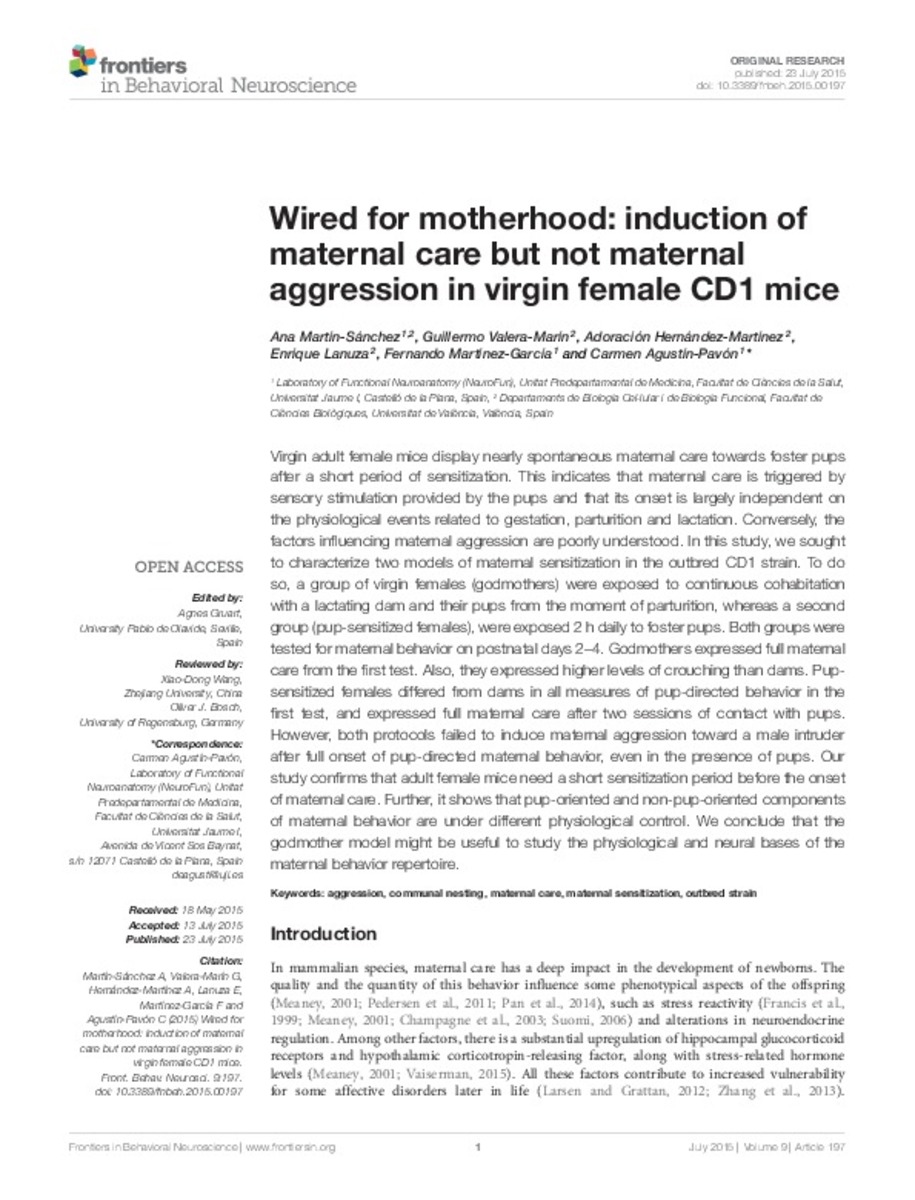Mostrar el registro sencillo del ítem
Wired for motherhood: induction of maternal care but not maternal aggression in virgin female CD1 mice
| dc.contributor.author | Martín Sánchez, Ana | |
| dc.contributor.author | Valera Marín, Guillermo | |
| dc.contributor.author | Hernández Martínez, Adoración | |
| dc.contributor.author | Lanuza, Enrique | |
| dc.contributor.author | Martinez-Garcia, Fernando | |
| dc.contributor.author | Agustín-Pavón, Carmen | |
| dc.date.accessioned | 2016-04-26T13:11:44Z | |
| dc.date.available | 2016-04-26T13:11:44Z | |
| dc.date.issued | 2015 | |
| dc.identifier.citation | MARTÍN-SÁNCHEZ, Ana, et al. Wired for motherhood: induction of maternal care but not maternal aggression in virgin female CD1 mice. Frontiers in behavioral neuroscience, 2015, vol. 9. | ca_CA |
| dc.identifier.issn | 1662-5153 | |
| dc.identifier.uri | http://hdl.handle.net/10234/158963 | |
| dc.description.abstract | Virgin adult female mice display nearly spontaneous maternal care towards foster pups after a short period of sensitization. This indicates that maternal care is triggered by sensory stimulation provided by the pups and that its onset is largely independent on the physiological events related to gestation, parturition and lactation. Conversely, the factors influencing maternal aggression are poorly understood. In this study, we sought to characterize two models of maternal sensitization in the outbred CD1 strain. To do so, a group of virgin females (godmothers) were exposed to continuous cohabitation with a lactating dam and their pups from the moment of parturition, whereas a second group (pup-sensitized females), were exposed 2 h daily to foster pups. Both groups were tested for maternal behavior on postnatal days 2–4. Godmothers expressed full maternal care from the first test. Also, they expressed higher levels of crouching than dams. Pup-sensitized females differed from dams in all measures of pup-directed behavior in the first test, and expressed full maternal care after two sessions of contact with pups. However, both protocols failed to induce maternal aggression toward a male intruder after full onset of pup-directed maternal behavior, even in the presence of pups. Our study confirms that adult female mice need a short sensitization period before the onset of maternal care. Further, it shows that pup-oriented and non-pup-oriented components of maternal behavior are under different physiological control. We conclude that the godmother model might be useful to study the physiological and neural bases of the maternal behavior repertoire. | ca_CA |
| dc.format.extent | 12 p. | ca_CA |
| dc.format.mimetype | application/pdf | ca_CA |
| dc.language.iso | eng | ca_CA |
| dc.publisher | Frontiers Media | ca_CA |
| dc.relation.isPartOf | Front. Behav. Neurosci., 23 July 2015 | ca_CA |
| dc.rights | Copyright © 2015 Martín-Sánchez, Valera-Marín, Hernández-Martínez, Lanuza, Martínez-García and Agustín-Pavón. This is an open-access article distributed under the terms of the Creative Commons Attribution License (CC BY). The use, distribution and reproduction in other forums is permitted, provided the original author(s) or licensor are credited and that the original publication in this journal is cited, in accordance with accepted academic practice. No use, distribution or reproduction is permitted which does not comply with these terms. This Document is Protected by copyright and was first published by Frontiers. All rights reserved. it is reproduced with permission. | ca_CA |
| dc.rights | Attribution 4.0 Spain | * |
| dc.rights.uri | http://creativecommons.org/licenses/by-sa/4.0/ | * |
| dc.subject | Aggression | ca_CA |
| dc.subject | Communal nesting | ca_CA |
| dc.subject | Maternal care | ca_CA |
| dc.subject | Maternal sensitization | ca_CA |
| dc.subject | Outbred strain | ca_CA |
| dc.title | Wired for motherhood: induction of maternal care but not maternal aggression in virgin female CD1 mice | ca_CA |
| dc.type | info:eu-repo/semantics/article | ca_CA |
| dc.identifier.doi | http://dx.doi.org/10.3389/fnbeh.2015.00197 | |
| dc.rights.accessRights | info:eu-repo/semantics/openAccess | ca_CA |
| dc.relation.publisherVersion | http://journal.frontiersin.org/article/10.3389/fnbeh.2015.00197/full#h1 | ca_CA |
| dc.type.version | info:eu-repo/semantics/publishedVersion |
Ficheros en el ítem
Este ítem aparece en la(s) siguiente(s) colección(ones)
-
MED_Articles [637]
Articles de publicacions periòdiques
Excepto si se señala otra cosa, la licencia del ítem se describe como: Copyright © 2015 Martín-Sánchez, Valera-Marín, Hernández-Martínez, Lanuza, Martínez-García and Agustín-Pavón. This is an open-access article distributed under the terms of the Creative Commons Attribution License (CC BY). The use, distribution and reproduction in other forums is permitted, provided the original author(s) or licensor are credited and that the original publication in this journal is cited, in accordance with accepted academic practice. No use, distribution or reproduction is permitted which does not comply with these terms.
This Document is Protected by copyright and was first published by Frontiers. All rights reserved. it is reproduced with permission.








